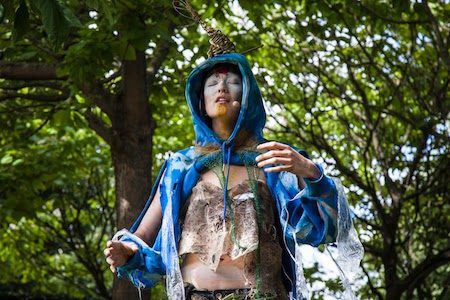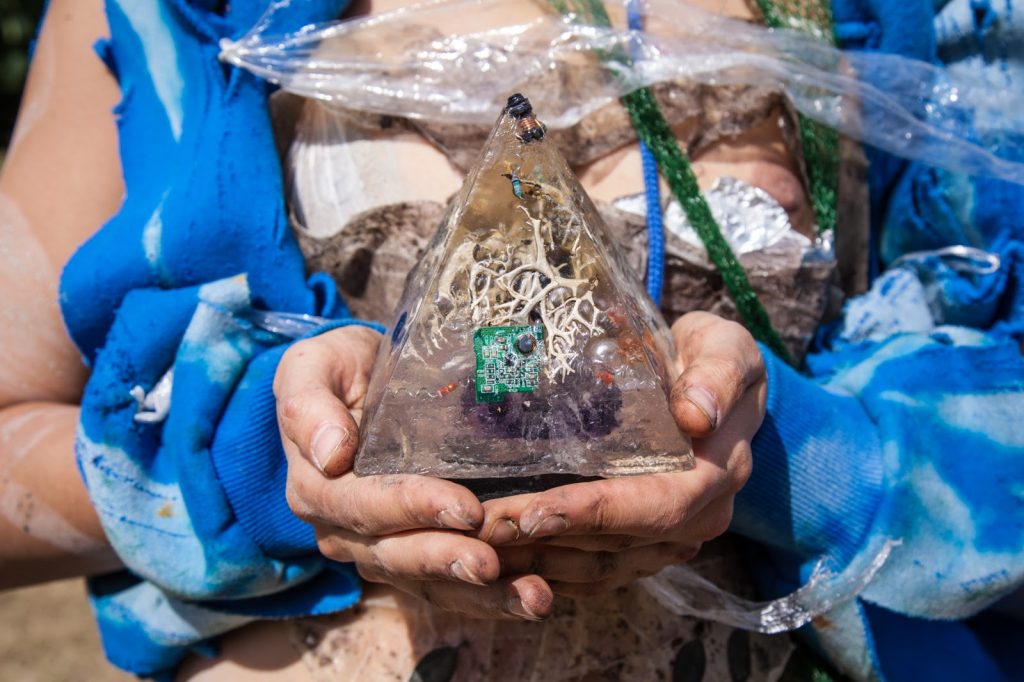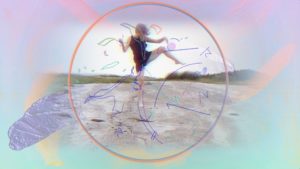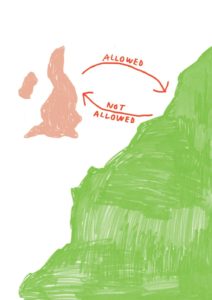“Anyone walking by probably thought we were all tripping,” Ayesha Tan-Jones says of their most recent session of Shadow Sistxrs Fight Club, a self-defence class that the artist runs for women, non-binary people and QTIPoC. Tan-Jones makes a spherical shape with their hands to re-enact the ‘energy bubbles’ that participants were asked to imagine and move with throughout the class. Whether they are teaching people how to protect themselves with their bodies, making music under the moniker YaYa Bones, or foraging for materials for their art practice, Tan-Jones gets a thrill out of blurring binaries. They traverse dimensions—between self-defence and healing, art and craft, fiction and reality—through their work and the confusion that this might cause for audiences (or simply passersby) is something that the artist welcomes with open, sphere-shaped arms.

Trained as a sculptor at Central Saint Martins, Tan-Jones sees all facets of their practice as a way of shaping material, sound, bodies and energy. Most recently, their work has taken a performative turn, with the opera ‘Parasites of Pangu’ making its debut at Res. in Deptford in April and traveling to Serpentine Gallery this past July. The piece is based on an ancient Chinese creation myth, titled ‘Pangu and the Cosmic Egg’, which follows the story of Pangu, a furry being with horns who is the creator of all things, and ends with the parasites on its body growing into humans. Finding issue with the creature’s depiction as a man, however, Tan-Jones continues the story from an overtly queer and diasporic perspective. The ‘Parasites of Pangu’ wake up in the future after being put into hypersleep, only to realise that they are the only people to reanimate and have become the new elements of the apocalypse: Flame of Perpetual Darkness, Swamp Witch, Prinx of the Underground and Last Breath. “But in my head, the story continues,” Tan-Jones says in a hushed voice. “There’s more people on Earth, but no one knows yet!”
‘Parasites of Pangu’ is what Tan-Jones calls an ‘optimystic dystopia’, which merges the destructive sentiment of our current moment with feelings of optimism and healing as we look to the past in hopes of a better future. From makeup made from natural pigments, like spirulina, beetroot, turmeric, charcoal and blackberries, to cheesy pop songs and fight scenes choreographed with the help of Monique Etienne, Chantel Foo, Chiyo Gomes and Yodea Marquel Williams, Tan-Jones’ work is an assemblage of anomalies. By layering contemporary crises with fantasy, humor and weirdness, the artist constructs alternative realities in order to reveal how constructed our own world is. In ‘Parasites of Pangu’, they speak to us as a psychic archaeologist that has dug up remnants from the future, posing quite an odd contrast against the families walking through Hyde Park on a Saturday afternoon. Some pause to take in the painted and tattered ‘Parasites’ before moving on, while others stick around to see how the story ends.
**Your work has many layers to it, from sculpture and installation to self-defence, music and, most recently, performance. Could you talk about your practice and where you begin with a project like ‘Parasites of Pangu’?
Ayesha Tan-Jones: I’ve always considered myself a sculptor first and foremost, but I see that embodied in all of my practice. I always use the blueprints of sculpture—everything becomes a physical ‘thing’—even if it is ephemeral or only exists for that one moment as performance. Even with my self-defence class, I see it as a way of sculpting space and peoples’ energies.
‘Parasites of Pangu’ began as a sculptural installation at Res. for their show Alembic. I performed the first 15 minutes of the opera within the space as an activation of the sculptures and I really enjoyed it, so I continued to develop the opera.
**What have you been able to achieve through performance that you might not have with another medium?
ATJ: Collaboration is an important thing that performance brings. When it comes to my physical pieces, I like to do everything myself. With a performance, I know that other people have skill sets that I don’t have, so it forces me to let go of that control and trust someone else’s vision. All of the collaborators are friends of mine, and transforming friendship into creation is a fucking epic thing.

**Have you carried that into the rest of your practice?
ATJ: I’ve been working more collaboratively over the past couple of years, especially with Shadow Sistxrs Fight Club. I like to facilitate ways of exploring the more childlike side of craft, making something without caring whether or not it’s beautiful. When it comes to myself, I always want to control everything and I forget to let myself be that child, so that is something that I am relearning through collaboration.
**You reference pop culture and take on different personalities in your work. Could you talk about these identities in relation to your practice?
ATJ: I started using different identities in my work at art school. I was making work that was really personal to me and having that work critiqued at school was the hardest thing. I started channeling my feelings through other characters so that I could separate myself from them and be more self-analytical, as well. Una Jynxx was my first character. She’s a 16-year old mystic blogger and I first came out as a witch through her. With Indigo Zoom, I just really wanted to be a superhero, so the characters are vessels for different things I want to explore.
**‘Parasites of Pangu’ is post-apocalyptic and there seems to be a simultaneous nostalgia, a looking-back, and a sense of futurity in your work. What is your relationship with time, fiction and myth?
ATJ: The timeline of my work is non-linear. All of my characters exist in the same universe, but at different moments. What’s important for me is to create narratives that are relatable but enough of a fantasy for people to be entertained by them. ‘Parasites of Pangu’ is about the apocalypse and climate destruction, but I didn’t want it to be too depressing or documentarian. That’s why I love sci-fi and speculative fiction, because you can create ways of saving or changing the world through a story.
It’s also important for me to reclaim myths in a queer, or more true, way. In ancient Chinese myths, Pangu is often represented as a man, but that’s impossible. Before anyone created the world, they can’t have created gender because gender is itself a myth, so in my opera Pangu is referred to as ‘they’. Also as a spiritual person and a Chinese person of the diaspora, I want to reconnect with what my ancestors believed.

**The Earth and the environment are also central to your practice, from the materials you use to the content of your work. What does a sustainable art practice look like for you and how can you combat environmental issues through your work?
ATJ: When I was more naive about my impact on the planet, I would use really toxic materials just because they looked sick, but I’m moving away from that now. The first time I performed ‘Parasites of Pangu’, I had this birthing pool filled with water from my local river, which had been polluted by an oil spill. The idea came from a lake in Mongolia which is near a lot of factories that make iPhone parts, and all of the excess water waste is piped into the lake, so it’s now super toxic and has created hybrid animals and death. The lake itself is weirdly beautiful, though, with criss-crossing pipes running through it; so it’s about turning waste into something beautiful and healing. For the Serpentine, the only new material that we bought was latex and everything else was foraged from my street. Not only is that helpful in terms of budget, but it’s the sort of environmental practice that I want to be embodying.
**You refer to the opera as a ‘optimystic dystopia’ in the accompanying text. Could you talk about that and how it might be different from utopia?
ATJ: I was trying to figure out where my work fits in relation to utopia or dystopia (not that the two are necessarily binary). I came up with ‘optimystic dystopia’ because I was experiencing grief and depression about the state of the world. So many of us are searching for a utopia but my utopia differs from someone else’s utopia, so we’re never going to have this uniform utopia. We are living in a perpetual dystopia, so instead of having all of these unattainable expectations, ‘optimystic dystopia’ allows you to do what you can to heal yourself and your community. For me, optimystic (spelled with a ‘y’) also means reconnecting to some form of spirituality—whatever form it may take—and connecting back to the Earth even in its new hybrid toxicity.**















